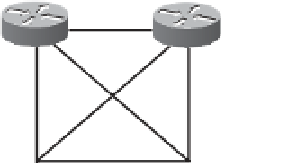Information Technology Reference
In-Depth Information
performance when resources are accessed through the central hub router from the spoke
routers, such as with spoke-to-spoke network traffic.
Full Mesh
To p o l o g y
Partial Mesh
To p o l o g y
Hub and Spoke
To p o l o g y
Figure 7-1
WA N To p o l o g i e s
Full-Mesh Topology
With full-mesh topologies, each site has a connection to all other sites in the WAN cloud
(any-to-any). As the numbers of sites grow, so does the number of spoke connections that
are ultimately required. Consequently, the full-mesh topology is not viable in very large
networks. However, a key advantage of this topology is that it has plenty of redundancy in
the event of network failures. But redundancy implemented with this approach does have
a high price associated with it.
Here are some issues inherent with full-mesh topologies:
Many virtual circuits (VC) are required to maintain the full mesh.
■
Issues occur with the amount of broadcast and multicast replication packets for
each site.
■
Complex configurations are needed.
■
High cost.
■
The number of VCs required for a full mesh can be calculated using the formula ((N - 1) x
N / 2). For example if you have 4 sites, ((4 - 1) x 4 / 2) = 6 VCs are required.
Partial-Mesh Topology
not all sites in the cloud are required to be connected to each other. However, some sites






